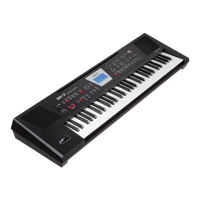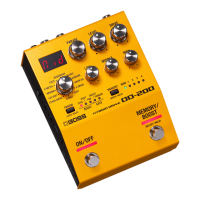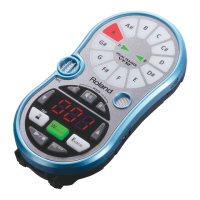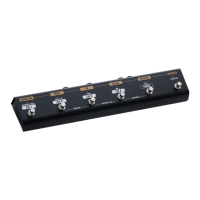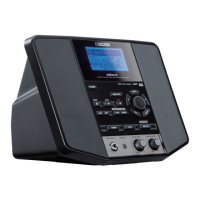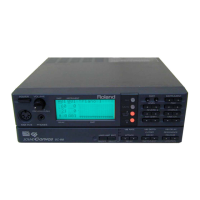MFX types and parameters
108
r
Backing Module BK-7m
9. Rotary
This effect simulates the sound of the rotary speakers often
used with the electric organs. Since the movement of the high-
range and low-range rotors can be set independently, the
unique type of modulation characteristic of these speakers can
be simulated quite closely. This effect is most suitable for elec-
tric organ sounds (of the
[ORGAN]
bank – the Harmonic Bar sec-
tion has its own Rotary effect).
●
Tweeter Slow Rate (0.05~10.0Hz)
●
Woofer Slow Rate (0.05~10.0Hz)—Slow speed (SLOW) of the
high- or low-frequency rotor.
●
Tweeter Fast Rate (0.05~10.0Hz)
●
Woofer Fast Rate (0.05~10.0Hz)—Fast speed (FAST) of the high-
or low-frequency rotor.
●
Rotary Speed (Slow, Fast)—Simultaneously switches the rota-
tional speed of the low-frequency and high-frequency rotors.
SLOW: Slows down the rotation to the “Slow Rate”. FAST:
Speeds up the rotation to the “Fast Rate”.
●
Tweeter Acceleration (0~15)
●
Woofer Acceleration (0~15)—Adjusts the time it takes the rotor
in question to reach the newly selected speed (“Fast” or
“Slow”). Lower values correspond to slower transitions.
●
Tweeter Level (0~127)
●
Woofer Level (0~127)—Volume of the rotor in question.
●
Separation (0~127)—Spatial dispersion of the sound.
●
Level (0~127)—Output level.
10. Compressor
Reduces high levels (peaks) and boosts low levels, smoothing
out fluctuations in volume.
●
Compressor Sustain (0~127)—Allows you to specify how
strongly incoming signals should be compressed, which results in
a longer sustain.
●
Compressor Attack (0~127)—Sets the speed at which compres-
sion starts.
●
Panpot (L64~0~63R)—Stereo location of the output sound. This
is a mono effect that combines incoming signals. You can, how-
ever, place the processed signal anywhere between the left and
right channels.
●
Compressor Post Gain (0, +6, +12, +18dB)—Adjusts the output
gain. Use this parameter to make up for a significant volume
loss due to extreme settings.
●
EQ Low Gain (–15dB~0~15dB)—Gain of the low range.
●
EQ High Gain (–15dB~0~15dB)—Gain of the high range.
●
Level (0~127)—Output level.
11. Limiter
Compresses signals that exceed the specified level, preventing
distortion from occurring. Unlike a compressor, it does not
boost the level of weaker signals.
●
Limiter Threshold (0~127)—Adjusts the volume at which com-
pression begins.
●
Limiter Release (0~127)—Allows you to specify how long signal
compression should remain in effect after the signal volume
falls below the Threshold value.
●
Limiter Ratio (1.5:1, 2:1, 4:1, 100:1)—Allows you to specify how
strongly volume peaks should be compressed. Choose “100:1” if
the Threshold level must never be exceeded (which is a true Lim-
iter function).
●
Panpot (L64~0~63R)—Stereo location of the output sound. This
is a mono effect that combines incoming signals. You can, how-
ever, place the processed signal anywhere between the left and
right channels.
●
Limiter Post Gain (0, +6, +12, +18dB)—Adjusts the output gain.
Use this parameter to make up for a significant volume loss due
to extreme settings.
●
EQ Low Gain (–15dB~0~15dB)—Gain of the low range.
●
EQ High Gain (–15dB~0~15dB)—Gain of the high range.
●
Level (0~127)—Output level.
12. Hexa-Chorus
Uses a six-phase chorus (six layers of chorused sound) to create
a dense and spatial effect.
●
Chorus Pre Delay (0.0~100.0ms)—Adjusts the delay between the
incoming direct signal and the moment when the chorus starts
working.
●
Chorus Rate (0.05~10.0Hz)—Frequency, i.e. modulation speed.
●
Chorus Depth (0~127)—Modulation intensity.
●
Chorus Pre Delay Deviation (0~20)—Adjusts the differences in
Pre Delay between each chorus line (there are six of them).
●
Chorus Depth Deviation (-20~0~20)—Adjusts the difference in
modulation depth between each chorus sound.
●
Chorus Pan Deviation (0~20)—Adjusts the distribution of the
various chorus lines in the stereo image.
0: All chorus sounds are in the center.
20: Each chorus sound will be spaced at 60 degree intervals rela-
tive to the center.
●
Balance (D100:0W, D50:50W, D0:100W)—Volume balance
between the direct (D) and the effect sound (W).
●
Level (0~127)—Output level.
13. Trem Chorus
This is a chorus effect with added Tremolo (cyclic modulation
of volume).
●
Chorus Pre Delay (0.0~100.0ms)—Adjusts the delay between the
incoming direct signal and the moment when the chorus starts
working.
●
Chorus Rate (0.05~10.0Hz)—Frequency, i.e. modulation speed.
●
Chorus Depth (0~127)—Modulation intensity.
●
Tremolo Rate (0.05~10.0Hz)—Modulation frequency of the
tremolo effect.
●
Tremolo Separation (0~127)—Allows you to set the level of the
tremolo effect with respect to the chorus modulation.
●
Tremolo Phase (0~180 deg)—Spread of the tremolo effect.
●
Balance (D100:0W, D50:50W, D0:100W)—Volume balance
between the direct (D) and the effect sound (W).
●
Level (0~127)—Output level.
14. Space-D
This is a multiple chorus that applies two-phase modulation in
stereo. It gives no impression of modulation, but produces a
transparent chorus effect.
●
Chorus Pre Delay (0.0~100.0ms)—Adjusts the delay between the
incoming direct signal and the moment when the chorus starts
working.
●
Chorus Rate (0.05~10.0Hz)—Frequency, i.e. modulation speed.
●
Chorus Depth (0~127)—Modulation intensity.
●
Chorus Phase (0~180deg)—Spatial spread of the sound.
●
EQ Low Gain (–15dB~0~15dB)—Gain of the low range.
●
EQ High Gain (–15dB~0~15dB)—Gain of the high range.
●
Balance (D100:0W, D50:50W, D0:100W)—Volume balance
between the direct (D) and the effect sound (W).
●
Level (0~127)—Output level.
15. St. Chorus
This is a stereo chorus. A filter is provided so that you can
adjust the timbre of the chorus sound.
●
Filter Type (OFF, LPF, HPF)—Type of filter. OFF: no filter is used.
LPF: cuts the frequency range above the Cutoff value. HPF: cuts
the frequency range below the Cutoff value.
●
Cutoff Frequency (200~8000Hz)—Basic frequency of the filter.
●
Chorus Pre Delay (0.0~100.0ms)—Adjusts the delay between the
incoming direct signal and the moment when the chorus starts
working.
●
Chorus Rate (0.05~10.0Hz)—Frequency, i.e. modulation speed.
●
Chorus Depth (0~127)—Modulation intensity.
●
Chorus Phase (0~180 deg)—Spatial spread of the sound.
●
EQ Low Gain (–15dB~0~15dB)—Gain of the low range.
●
EQ High Gain (–15dB~0~15dB)—Gain of the high range.
●
Balance (D100:0W, D50:50W, D0:100W)—Volume balance
between the direct (D) and the effect sound (W).
●
Level (0~127)—Output level.
BK-7m_UK.book Page 108 Tuesday, January 4, 2011 9:25 AM

